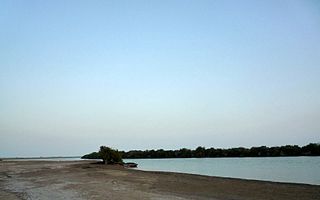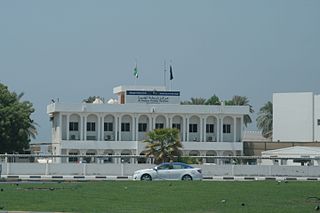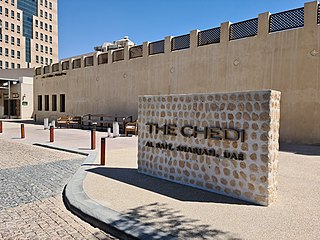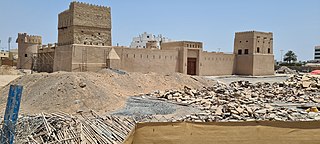
The Emirate of Sharjah is one of the emirates of the United Arab Emirates, which covers 2,590 square kilometres (1,000 sq mi) and has a population of over 1,400,000 (2015). It comprises the capital city of Sharjah, after which it is named, and other minor towns and exclaves such as Kalba', Al Dhaid, Dibba Al-Hisn and Khor Fakkan.

Ras Al Khaimah (RAK) is the northernmost of the seven emirates that make up the United Arab Emirates (UAE). The city of Ras Al Khaimah, abbreviated to RAK or RAK City, is the capital of the emirate and home to most of the emirate's residents. It is linked to the Islamic trading port of Julfar. Its name in English means "headland of the tent". The emirate borders Oman's exclave of Musandam, and occupies part of the same peninsula. It covers an area of 2,486 km2 (960 sq mi) and has 64 km (40 mi) of beach coastline. As of 2015, the emirate had a population of about 345,000.

Dhaid, or Al Dhaid, is the capital of the Central Region of the Emirate of Sharjah in the United Arab Emirates. An oasis town, it has extensive irrigated date palm plantations with water channelled from the nearby Hajar mountains, at least in part through ancient tunnels dug for that purpose, known as aflāj in Arabic.

Kalba is a city in the Emirate of Sharjah in the United Arab Emirates (UAE). It is an exclave of Sharjah lying on the Gulf of Oman coast north of Oman. Khor Kalba, an important nature reserve and mangrove swamp, is located south of the town by the Omani border.

Sheikh Saqr bin Mohammed Al Qasimi was the Ruler of the Emirate of Ras Al Khaimah from 1948 to 2010. On 10 February 1972, under his leadership, Ras Al Khaimah become the seventh Trucial State to join the United Arab Emirates.

Sharjah is the third-most populous city in the United Arab Emirates, after Dubai and Abu Dhabi. It is the capital of the Emirate of Sharjah and forms part of the Dubai-Sharjah-Ajman metropolitan area.

Khalid bin Sultan Al Qasimi, known professionally as Khalid Al Qasimi, was an Emirati royal and fashion designer in London who founded the Qasimi fashion label. He was the second son of Sultan bin Muhammad Al-Qasimi, who has been ruler of the Emirate of Sharjah since 1972. Al Qasimi died in London on 1 July 2019.

Al Heera is a suburb in Northern Sharjah in the United Arab Emirates, traditionally home to the Al Bu Shamis section of the Na'im tribe. At one stage declaring its independence from Sharjah, with its own Sheikh, it formally became part of the Emirate of Sharjah in 1942 on the death of its Ruler, Abdulrahman Al Shamsi. A coastal settlement with a small harbour formerly used by a number of fishermen and pleasure boat owners, its main distinguishing feature today is its police station, converted in 2019 into the 'Al Heera Literature Society' building.

Mahatta Fort is located in central Sharjah in the United Arab Emirates. The fort was built by the Ruler of Sharjah in 1932 to afford protection for the passengers and staff of Imperial Airways. It was the first British establishment on the Trucial Coast, after an agreement was struck between the British government and the ruler of Sharjah in June 1932. The Fort was used by the Royal Air Force in World War II and the Trucial Oman Scouts before briefly becoming a hotel, a police station and is now an aviation museum, known as Al Mahatta Museum.

Umm Al Quwain Fort, also known as the Al Ali Fort, is located in the city of Umm Al Quwain in the United Arab Emirates (UAE). It was the seat of the rulers of Umm Al Quwain and the centre of government in the emirate until 1969. It was used as a police station before the fort was restored and opened to the public in 2000 by Sheikh Rashid Bin Ahmed Al Mualla, the Ruler of Umm Al Quwain at the time.
Sheikh Khalid bin Ahmad Al Qasimi was the Ruler of Sharjah, a Trucial State and now one of the United Arab Emirates, from 1914–1924 and Ras Al Khaimah from 1914–1921. He acceded on the death of Saqr bin Khalid Al Qasimi. His rule was tumultuous and unpopular, marked by internecine conflicts and public discontent and saw the final disintegration of the Al Qasimi's joint rule over Sharjah and Ras Al Khaimah. Deposed as Ruler of Sharjah in 1924, he went on to become ruler of Dhaid and Kalba and a highly influential figure in the Shamaliyah.
Sheikh Sultan II bin Saqr Al Qasimi was the Ruler of Sharjah, a Trucial State and now one of the United Arab Emirates, from 1924 to 1951. His father having ceded the rule of Sharjah to Khalid bin Ahmad Al Qasimi, Sultan found himself dispossessed and married the daughter of Abdulrahman bin Shamsi, the headman of Al Heera. Buoyed by Khalid's unpopularity and Abdulrahman's force of personality and arms, Sultan deposed Khalid and became Ruler of Sharjah. However, he found the interior of the country dominated by Bedouin tribes and the East coast increasingly dominated by the former Ruler, Khalid bin Ahmad, leaving Sultan the effective ruler of a cluster of coastal settlements, many of which constantly tried to secede from his rule. He is cited as having presided over a low ebb in the power of the Al Qasimi, formerly a powerful maritime federation.
Sheikh Sultan bin Salim Al Qasimi was Ruler of Ras Al Khaimah from 1921–1948. His long and turbulent rule was characterised by internecine family and tribal disputes and he was finally removed as Ruler in a 1948 coup.
Sheikh Hamad bin Ibrahim Al Mualla was Ruler of Umm Al Quwain from 1923 to 1929, one of the Trucial States which today forms part of the United Arab Emirates (UAE).
Sheikh Hamad bin Abdullah Al Sharqi was the first recognised leader of the Al Sharqi Ruling family of Fujairah, one of the Trucial States and today one of the United Arab Emirates (UAE). He led Fujairah in a number of insurrections against Al Qasimi rule, presiding over a turbulent time when the emirate was practically independent but denied recognition of status as a Trucial State in its own right by the British.
Wadi Helo is a seasonal watercourse located in the Hajar Mountains of Sharjah, in the United Arab Emirates. The wadi runs northwest to southeast of the eponymous village of Wadi Helo, located on the Sharjah-Kalba highway.

The Chedi Al Bait Hotel is a 53-room five star heritage hotel situated in the Heart of Sharjah cultural heritage area in Sharjah, United Arab Emirates – a restoration of the traditional trading and residential district of Sharjah town.

Dhaid Fort, is a restored C18th fortification in the city of Dhaid, Sharjah, in the United Arab Emirates. It has long been an important stronghold for the Ruling families of Sharjah and Ras Al Khaimah and a key strategic asset in maintaining a historical Qawasim dominance of the inland areas of the Northern Emirates.

Fili Fort is a late Islamic fortification located to the east of the town of Madam, in the United Arab Emirates' emirate of Sharjah.
Abdulrahman bin Muhammad Al Shamsi was the Sheikh, or head man, of the township of Al Heera, today a suburb of Sharjah in the United Arab Emirates. A highly influential and often divisive figure in regional politics during the early 20th century in the Trucial States, he was referred to by one British Political Resident as ‘a stormy petrel of the Trucial Coast, a man feared by everyone in and around Sharjah’.















